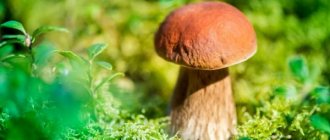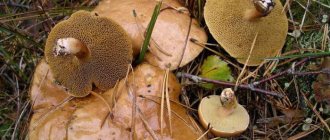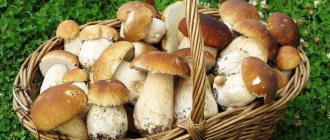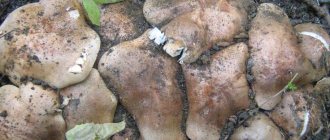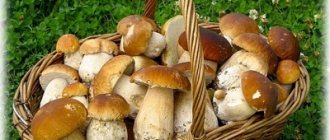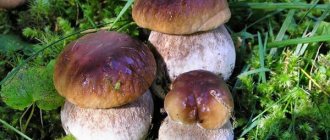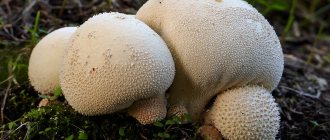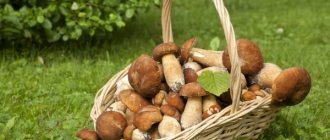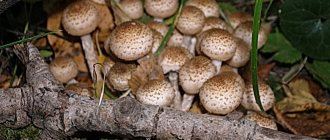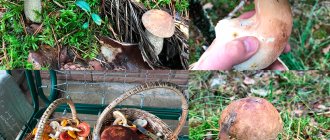The territory of the Ryazan region is famous for its wide mushroom areas, rich not only in edible and conventional, but also poisonous fruits. Therefore, in order not to make mistakes during a quiet hunt, you should familiarize yourself in more detail with the distinctive features, descriptions and areas where they most often sprout: boletus, obabka, Polish and porcini mushrooms, champignons and chanterelles. After all, the mushrooms of the Ryazan region in 2021 have already begun to bear fruit since April, and will continue to reward their guests until the first frost.
What mushrooms grow in Ryazan?
The Ryazan region in terms of mushroom fruiting can only be compared with the Moscow and Voronezh regions, where mushroom pickers collect more than one bucket at a time. Favorable weather makes it possible to accommodate more than 90 species of edible species in mixed, deciduous and coniferous forests.
Among the many mushrooms, 2022 pleased mushroom pickers with a treasure trove of edible and conditionally edible mushrooms:
- white;
- milk mushrooms;
- Polish;
- obabkov;
- chanterelles;
- kids;
- moss mushrooms;
- oily;
- morels and pods;
- priests (umbrellas);
- russula;
- again.
It is best to look for oil beetles in pine needles, near young pines. They can be found less often in tall grass. Boletuses love hills and small tubercles protruding on a flat surface. Polish and obabka can be found next to trees in mixed and deciduous forests.
The most delicious mushrooms are considered to be: white mushrooms, aspen and boletus mushrooms, oak mushrooms, umbrellas and milk mushrooms. For making pickles and pates, the following are suitable: honey mushrooms, saffron milk caps, chanterelles and volushki. Suitable for freezing: bluelegs, honey mushrooms and shitatka.
Evaluation of taste qualities, medicinal properties, benefits and possible harm
Bluefish have excellent taste. Their flesh resembles chicken meat and is similar to young champignons. It has antibacterial, antioxidant, antiviral, anti-inflammatory and immunomodulatory properties.
Advantages of rowing:
- has a beneficial effect on the cardiovascular system;
- relieves chronic fatigue and headaches;
- normalizes blood sugar levels;
- increases physical and mental activity;
- normalizes the functioning of the gastrointestinal tract;
- removes waste and toxins;
- strengthens the immune system.
In folk medicine, bluelegs is used to make antibiotics and anti-inflammatory drugs.
An extract is created from the mycelium that reduces the activity of cancer cells. Infusion and lilac-legged rower are used to prepare various ointments for the treatment of skin diseases.
Doctors recommend consuming mushrooms for nervous disorders and diabetes. Rowing is useful for people suffering from diseases of the liver and genitourinary system.
Another area of application of the mushroom is cosmetology. The dried row is ground into powder and a facial lotion is created on its basis. The product is recommended for people with increased secretion of subcutaneous fat, irritation and acne.
Eating raw bluefish can cause serious problems.
Overgrown mushrooms absorb various harmful substances: copper, mercury, cadmium, pesticides. Eating such mushrooms leads to flatulence, pain and heaviness in the stomach.
It is not recommended to eat a lot of botanicals with low acidity. Serious contraindications are: pancreatitis, cholecystitis, chronic gastrointestinal diseases and gallbladder dysfunction.
Composition and calorie content
This variety of mushrooms has a varied composition:
- minerals - calcium, phosphorus, potassium, selenium, sodium, zinc, manganese, iron, copper;
- vitamins - group of vitamins B, betaine, choline, ascorbic acid, vitamins A and D;
- natural antibiotics - clitocin and fomecin;
- polysaccharides;
- amino acids - there are 18 amino acids in the rows (the highest concentration of lysine, threonine, alanine, phenylalanine, glutamic, aspartic and stearic acid);
- phenol is an antiseptic substance.
100 grams of bluelegs contain 2.4 g of protein, 1.8 g of carbohydrates and 0.83 g of fat. Calorie content is only 20.2 kcal per 100 g. The optimal combination of biofuel and low calorie content makes mushrooms attractive to people who adhere to a healthy diet.
Poisonous mushrooms
The most common mushrooms in the Ryazan region are: red and royal fly agarics, pale toadstools and false mushrooms.
Fly agarics are very similar to russula, although their distinctive features are: a cylindrical shape, a skirt at the base of the leg and white spots on the cap, reminiscent of a trendy pea print. The last sign is not always significant. Sometimes, rain washes away the sprinkles on the cap, making the appearance of the poisonous mushroom similar to the completely edible and incredibly tasty marsh russula.
An inexperienced mushroom picker may confuse the pale toadstool with a forest or meadow champignon. Therefore, in order not to risk your health, you should refuse to collect if you are not sure of the origin of the mushroom found.
No less often in the forests you can see false honey mushrooms. Unlike edible breeds, their legs are completely smooth.
A distinctive feature of most inedible mushrooms is an unpleasant, one might even say repulsive, smell and bitter taste. Sometimes their aroma is somewhat reminiscent of the disgusting smell of ammonia or rotten food.
Important Tips
1) Unfortunately, in recent years many forests have become increasingly polluted. To avoid indigestion or worse, poisoning, you should collect only young fruits that are not exposed to toxins and carcinogens.
2) To reduce competition, it is preferable to go to the forest zone in the morning hours on weekdays, when most local residents of the Ryazan region are at work.
3) When collecting conventional and edible fruits that require heat treatment, do not rush, spending less time than recommended in the recipe.
4) Any recipe involves using one type of mushroom. You should not pickle several conventional or edible species at once.
5) Clothing for searches must be closed, preventing insect bites.
Mushroom places + photo map
In 2022, it is impossible to find a forest without mushrooms. Throughout the entire territory of the Ryazan region, nature strewn the mycelium with a rich harvest. And if in some places there are not so many of them, others delight their guests with edible fruits every day. Among the most popular places often mentioned on forums are:
1) Rural settlements of the Ryazan region, namely: Deulovo and Laskovo. There, residents and guests collect obabkas, slimy boletus and bright chanterelles.
2) Near the lakes Segdenskoye and Chernenkoye there are more and more porcini and Polish mushrooms, pig mushrooms and honey mushrooms.
3) The Iberd forest near the river will delight you with moss and boletus mushrooms, chanterelles and kids.
4) In the forest belt of the village of Tuma you can find almost all edible and conventional mushrooms. It’s true that there are plenty of inedible species in this territory. It is better for beginners not to go to this area alone; it is better to take with them experienced mushroom pickers who can accurately distinguish poisonous mushrooms from tasty and valuable ones.
5) Another storehouse of edible mushrooms was the territory of the Kiritsky forest, passing through the territory of the villages of Zadubravya and Shelukhova. The area is rich not only in spring and summer, but also in autumn species of mushrooms.
6) The forest of the village of Kochemary, located in the Kasimovsky district, bears fruit throughout the entire time - from the beginning of spring to the end of October. In rare cases, the harvest is preserved until the first frost.
Important information!
When going on a quiet hunt, you should remember safety rules. Clothing should completely cover arms and legs, and a hat should cover the scalp from ticks. It is better to prefer jeans as trousers - snakes will not be able to pierce them during an attack. However, like knee-length high rubber boots. You should not forget about the habitat of foxes and wolves in the territory.
Contraindications for use
People who are included in the list should not study mushroom places and mushrooms of the Ulyanovsk region in 2020:
- during pregnancy;
- during lactation;
- children under 13 years of age;
- those suffering from chronic gastrointestinal diseases;
- with exacerbations of the gastrointestinal tract;
- in case of product intolerance or allergy.
In 2022, in many regions of Russia you can pick up a lot of edible mushrooms. However, local residents of the Yaroslavl region are especially lucky, since despite the number of known edible items, the harvest is usually increased and does not depend on the chosen forest.
Share on social media networks
The forests of the Kaluga region are rich in edible mushrooms. Fruiting lasts from late spring and...
Even experienced gardeners know that planting tomato seedlings in open ground in 2022 deserves a special mention.
Lilac-legged rower (Lepista saeva)
- Other names for the mushroom:
- Lilac-legged row
- Two-color row
- Bluefoot
Other names:
Lilac-legged row;
The row is two-color;
Bluefoot;
- Submanager;
- Blue root;
- Lepista personata.
Lilac-footed row (Lepista saeva, Lepista personata) is a mushroom from the genus Ryadovok, belonging to the family Ryadovkov (Tricholomov). This type of mushroom is very resistant to cold weather, and its growing season can continue even when the outside temperature drops to -4ºC or -6ºC.
Interesting Facts
- Bluefoot is considered a delicacy in some countries: it is grown and exported.
- Mushroom powder is used in cosmetology to prepare lotion, which reduces sebum production;
- Bluefoot can be cultivated indoors or in the garden.
- Blueleg mushroom has a powerful antiviral effect.
Blueleg is a common mushroom with an unusual color and has good taste. Excellent for consumption boiled, fried and pickled. It is noteworthy that mushrooms grow in large groups. In one hunt you can collect more than 10 kg. Before collecting, it is important to familiarize yourself with row doubles, since most of them are poisonous.
Information sources
- Aurel Dermek. Mushrooms. - Bratislava: Slovart, 1989. - p. 76.
- Z. A. Klepinina and E. V. Klepinina. Mushroom Picker's Guide. - M.: AST-PRESS, 2006. - 256 s (p. 70)
- "Mushrooms". Directory. / lane from Italian F. Dvin - M.: AST. Astrel, 2004. - 303 s (p. 99)
- "Mushrooms. Reference guide. More than 120 species" / Compiled by N. E. Makarova - M.: AST, Minsk: Harvest, 2005—320 pp. (p. 224)
- Lesso, Thomas. Mushrooms. Determinant. / lane from English - M.: AST, 2007. - 304 s (p. 57)
- Korhonen Mauri. 100 mushrooms // Transl. from Finnish. - M.: Timber Industry, 1981.
Tips for beginners
To get only the benefits from mushrooms, you must follow the collection rules. Experienced mushroom pickers recommend going out into the forest early in the morning, especially in summer. The largest number of fruiting bodies are collected 2-3 days after rain.
Mushrooms are collected only with stems. It is by the legs that poisonous species are identified during sorting. If you decide to buy more mushrooms, pay attention to the fact that the caps must have stems. If the seller offers only “heads” of mushrooms, refuse to purchase. You will not be able to accurately determine whether the mushroom in front of you is a poisonous or an edible one.
You should not eat old mushrooms whose caps have opened and released spores.
The harvested crop must be washed under running water. Conditionally edible mushrooms require cooking for 10-20 minutes, the broth is drained.
